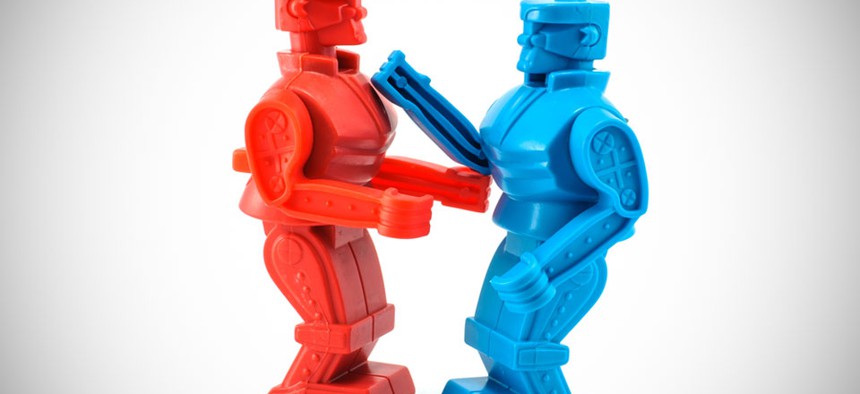Robot vs. Robot

PAISAN HOMHUAN/Shutterstock.com
Can a computer forge a painting well enough it fools the algorithms designed to detect fakes?
Beautiful mathematical patterns are hidden in the chaos of Jackson Pollock’s famous drip paintings. The repeating designs—fractals of grey, black, and yellow—were first uncovered in 1999 by Richard Taylor, a physicist from the University of Oregon. He proposed his findings in the journal Nature, and later suggested that computers could analyze the geometric patterns within the brush strokes to detect a Jackson Pollock fraud from an original.
To demonstrate his methods, Taylor and his colleagues planned to use the unique signatures they found to make a Jackson Pollock fake good enough to dupe art experts.
“However, we concluded that to generate this work would represent the dawn of a new and unwanted era,” Taylor told me in an email. “So we shelved the plan.”
As robots increasingly work (and play) in ways that once seemed fundamentally human, Taylor believes the art world is headed toward a turbulent time filled with difficult questions: If a computer can fake a painting, can it also fool the computers designed to detect the fakes? How can the programs designed to spot fakes stay a step ahead of the programs designed to generate them? The idea, he said, could trigger a particularly ominous cycle, considering the millions of dollars that could be made from forgeries.
The art world, Taylor said, has just passed through the first phase of answering these questions. His team, and more recently a team led by the computer scientist Lior Shamir from Lawrence Technological University in Michigan, has found that computers can use fractal analysis to distinguish between real Pollocks and imitations.
Shamir and his colleagues analyzed more than 100 paintings, including 26 original Jackson Pollocks, for traces of fractal patterns. To do so, the paintings were digitized in 640,000 pixels then cut into 16 different segments. Then, the computer would analyze the paintings segment by segment and determine whether each portion’s fractal patterns matched the mathematical features in Pollock’s work.
The computer, it turned out, was right about 93 percent of the time. Shamir and his team published their findings in the International Journal of Art and Technology.
Shamir believes that computers will eventually be able to create artwork indistinguishable from a person-made painting, an idea that’s still controversial in the art world. But robots are already dabbling in artistic pursuits—everything from acting to dancing to painting.
“If you remember during the 60s it was controversial whether a computer program could play chess and beat a person. It was controversial 'til the 90s when Deep Blue beat a chess master,” Shamir said. “It sounds like science fiction right now, but a computer beating a person in chess was also science fiction for a long time. It’s going to stay controversial until the day it actually happens.”
There are still plenty of limitations to what robots can discern about art—regardless of who or what made it.
About 10 years ago, Taylor’s algorithm was called into use by the Pollock-Krasner Foundation to verify the authenticity of 24 newly discovered Jackson Pollock paintings. He found “significant differences” in a quarter of them, which raised the possibility that they were fake. But researchers from Case Western University challenged his methods in an article in Nature, showing that a set of simple stars drawn by a child contained the same fractal statistics as a Pollock.
Daniel Rockmore, a mathematician from Dartmouth who applies mathematical models to artwork, said computer programs like Taylor’s could not reverse-engineer an entire Jackson Pollock masterpiece—which means computers might be adept at recognizing a Pollock, but they still haven’t figured out how to imitate one.
Instead, the programs would generate artworks based on a single signature—the fractal pattern identified as a defining characteristic of Pollock's work—but might otherwise miss the overarching aesthetic of an authentic Pollock. In other words, there’s no guarantee that the final robot-made product would look authentic to a human.
Indeed, in one case, when researchers reverse-engineered images of bikinis and golden retrievers from an algorithm designed to detect the items, it spewed back an unrecognizable mess of static hues. Just because a computer can recognize something doesn't mean it can reproduce that thing. (Humans, for the record, have similar artistic limitations.)
“It’s as if George Orwell used the word ‘the’ 2 percent of the time in every book that he wrote. Say I write a computer program in which two out of every 100 words is ‘the,’” Rockmore said. By including the word “the” in 2 percent of its text, that computer program could create a manuscript capable of convincing a fraud-detecting algorithm that it is an authentic George Orwell essay. But a skim of the entire text reveals the truth. “I’ve managed to match that one statistic, but it’s not George Orwell’s writing and no one would ever confuse it as such.”
Digitally, a computer program can create a piece of artwork that can pass for an original. But, materially, things get more complicated.
“Going from pixels to the actual painting strikes me as complicated,” Rockmore said. “But you wouldn’t want to say it could never be done.”
(Image via PAISAN HOMHUAN/ Shutterstock.com)
NEXT STORY: Inspector Gadget, but for Nuclear Waste





